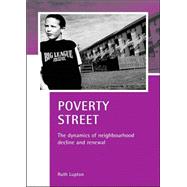
Note: Supplemental materials are not guaranteed with Rental or Used book purchases.
Purchase Benefits
Looking to rent a book? Rent Poverty Street [ISBN: 9781861345363] for the semester, quarter, and short term or search our site for other textbooks by Lupton, Ruth. Renting a textbook can save you up to 90% from the cost of buying.
| List of tables, figures and boxes | viii | ||||
| Acknowledgements | x | ||||
| List of acronyms | xiii | ||||
| Introduction | 1 | (14) | |||
|
1 | (4) | |||
|
5 | (2) | |||
|
7 | (2) | |||
|
9 | (3) | |||
|
12 | (3) | |||
| one The 12 disadvantaged areas | 15 | (24) | |||
|
15 | (7) | |||
|
22 | (9) | |||
|
31 | (5) | |||
|
36 | (3) | |||
| two Historical poverty and the roots of decline | 39 | (28) | |||
|
39 | (7) | |||
|
46 | (15) | |||
|
61 | (2) | |||
|
63 | (4) | |||
| three The 1990's: decline and divergence | 67 | (32) | |||
|
67 | (3) | |||
|
70 | (3) | |||
|
73 | (1) | |||
|
74 | (6) | |||
|
80 | (2) | |||
|
82 | (7) | |||
|
89 | (4) | |||
|
93 | (2) | |||
|
95 | (2) | |||
|
97 | (2) | |||
| four Management failure | 99 | (12) | |||
|
99 | (1) | |||
|
99 | (6) | |||
|
105 | (2) | |||
|
107 | (2) | |||
|
109 | (2) | |||
| five Social interaction and neighbourhood stigma | 111 | (12) | |||
|
111 | (1) | |||
|
111 | (3) | |||
|
114 | (2) | |||
|
116 | (3) | |||
|
119 | (2) | |||
|
121 | (2) | |||
| six Attempts at regeneration | 123 | (18) | |||
|
123 | (1) | |||
|
124 | (1) | |||
|
125 | (10) | |||
|
|||||
|
135 | (3) | |||
|
138 | (3) | |||
| seven New Labour and neighbourhood renewal | 141 | (14) | |||
|
141 | (1) | |||
|
142 | (2) | |||
|
144 | (2) | |||
|
146 | (2) | |||
|
148 | (1) | |||
|
149 | (1) | |||
|
149 | (3) | |||
|
152 | (3) | |||
| eight Making a difference? | 155 | (6) | |||
|
155 | (4) | |||
|
159 | (2) | |||
| nine Getting it together: new money and better partnerships | 161 | (14) | |||
|
161 | (1) | |||
|
161 | (6) | |||
|
167 | (2) | |||
|
169 | (3) | |||
|
172 | (3) | |||
| ten Drivers of change: population, housing and the economy | 175 | (16) | |||
|
175 | (3) | |||
|
178 | (3) | |||
|
181 | (5) | |||
|
186 | (2) | |||
|
188 | (3) | |||
| eleven New solutions? | 191 | (14) | |||
|
191 | (1) | |||
|
191 | (2) | |||
|
193 | (4) | |||
|
197 | (5) | |||
|
202 | (1) | |||
|
203 | (2) | |||
| twelve The end of Poverty Street? | 205 | (16) | |||
|
205 | (1) | |||
|
206 | (2) | |||
|
208 | (1) | |||
|
209 | (1) | |||
|
210 | (2) | |||
|
212 | (1) | |||
|
213 | (2) | |||
|
215 | (1) | |||
|
216 | (1) | |||
|
217 | (4) | |||
| Bibliography | 221 | (14) | |||
| Index | 235 |
The New copy of this book will include any supplemental materials advertised. Please check the title of the book to determine if it should include any access cards, study guides, lab manuals, CDs, etc.
The Used, Rental and eBook copies of this book are not guaranteed to include any supplemental materials. Typically, only the book itself is included. This is true even if the title states it includes any access cards, study guides, lab manuals, CDs, etc.